10+ SAMPLE Job Interview Meeting Minutes
-
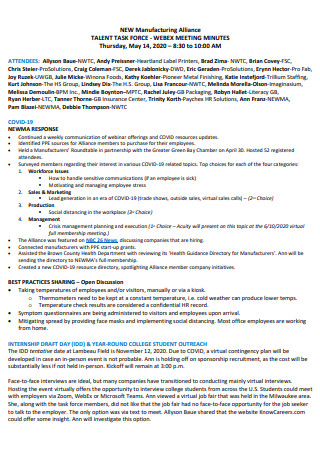
Sample Job Interview Meeting Minutes
download now -
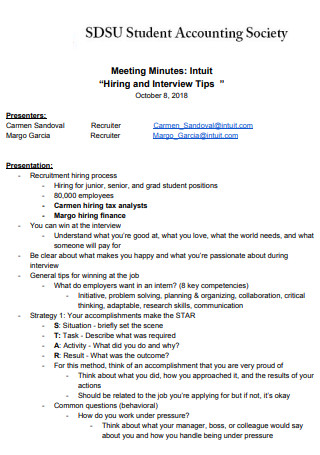
Printable Job Interview Meeting Minutes
download now -
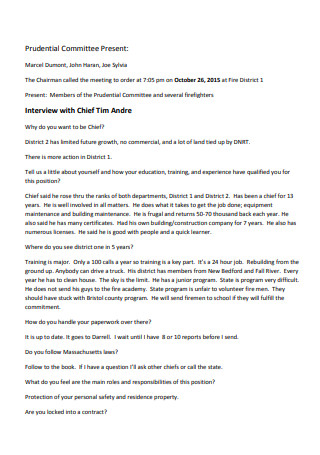
Standard Job Interview Meeting Minutes
download now -
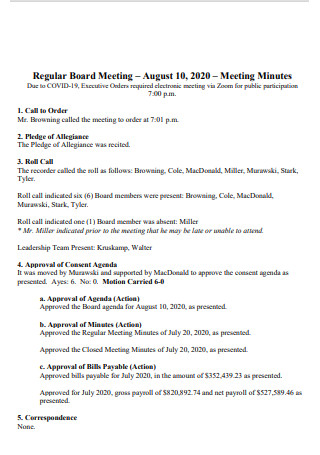
Formal Job Interview Meeting Minutes
download now -
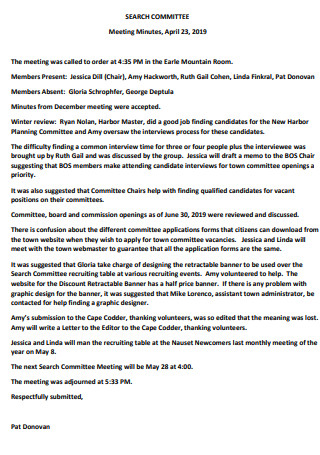
Job Interview Meeting Minutes Format
download now -
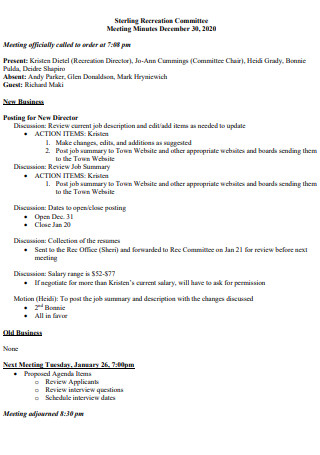
Professional Job Interview Meeting Minutes
download now -
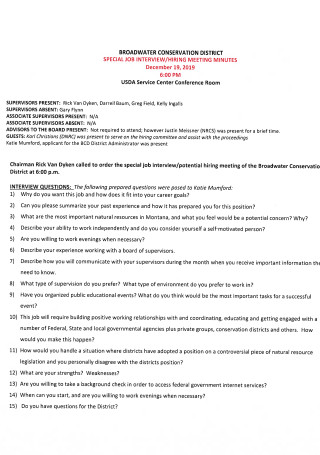
Special Job Interview Meeting Minutes
download now -

Strategic Job Interview Meeting Minutes
download now -

Basic Job Interview Meeting Minutes
download now -
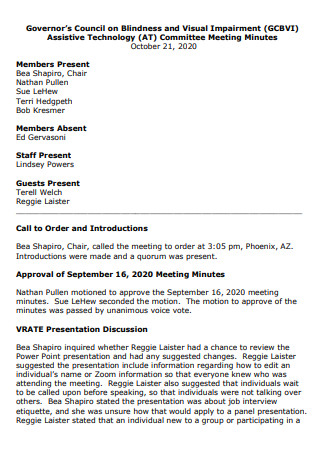
General Job Interview Meeting Minutes
download now -
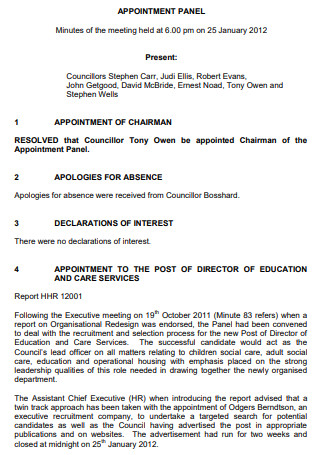
Editable Job Interview Meeting Minutes
download now
FREE Job Interview Meeting Minutes s to Download
10+ SAMPLE Job Interview Meeting Minutes
a Job Interview Meeting Minutes?
Benefits of Job Interviews
Tips To Pass a Job Interview
How To Write Meeting Minutes Effectively
FAQs
How do you keep track of interview minutes?
Is a brief interview a bad thing?
Is it considered impolite to take notes during an interview?
What Is a Job Interview Meeting Minutes?
Meeting minutes are specific records that serve as the official written record of a meeting. They typically include significant points discussed. Subsequently, critical details are summarized and outlined. Meeting minutes are essential for any organization because they serve as a future reference or proof of decisions. Or, in the case of a job discussion, a reference for managers or the human resource department to assist in screening job applicants and making a final decision. According to statistics, just 20% of persons who apply for a job receive an interview. Thus, around 17 prospects out of 118 are invited for a job interview.
Benefits of Job Interviews
Personal interviews are done by all employers and businesses when hiring new employees. The interview is a critical step in the personnel selection process, and it’s vital because they connect employers and job seekers. It assists employers in selecting the best candidate for the job. Additionally, it assists job seekers in presenting their job skills and obtaining the desired position based on merit. If you’re curious, here are some of its benefits.
Tips To Pass a Job Interview
If you’ve been invited to an interview, it implies the recruiting team has looked over your résumé and sees potential in you, but they want to learn more about what you can bring to the job. Here are some suggestions on how to give your best interview performance and boost your chances of getting hired:
1. Conduct extensive research.
Research the organization and learn about its mission and values and your interviewing work in the district. Demonstrate to an interviewer that you know the business, have industry knowledge, or have some insight into the company’s direction. Then, demonstrate how your abilities and experience would assist them in accomplishing their intentions. If you know the interviewers’ names, you can research them on the company’s staff pages or professional networking sites to better understand their experience and how it may influence their hiring choice. For instance, you may discover that your interviewer began in the same position you are applying for. You can use this information to inquire about their experience in the role and any extra qualifications they believe the job requires.
2. Dress for the job that you desire.
What you wear to an interview demonstrates your professionalism and aptitude for the job. Choose a professional yet comfortable outfit that will help you feel confident during the interview. It is preferable to dress somewhat more formally than the organization’s regular dress code. While researching the organization, you may also look online for photographs of their personnel to ascertain their dress code. For instance, if your organization favors business casual attire, your interview attire should reflect this preference.
3. Allow yourself to have time.
While you may have numerous qualifications to discuss during your interview, take a moment to take a big breath before responding. Taking this time to unwind and collect your ideas before your consultation might exhibit thoughtfulness. Additionally, pay close attention to each question and prompt. Make an effort to discuss only the most pertinent criteria for a specific topic to keep your responses short. Include one or two abilities and experiences at a time, clearly and gradually, to ensure the interviewer knows each qualification. Also, if you are unsure about a question, you can request clarification before responding. You can inquire whether you have answered a question completely to ensure that your response is sufficiently detailed. This may also elicit a follow-up question from the interviewer regarding the incident you just shared.
4. Bring a notepad and pen with you.
Bring a notepad and pen to record relevant information during the interview, such as the interviewers’ names and anything else that comes up. This phase demonstrates your attention to detail and organization while also providing notes to return to later and assisting you in writing your post-interview thank-you note. While taking notes, maintain eye contact with the interviewer and nod when they talk to you.
5. Utilize statistics and numbers to demonstrate your accomplishments and be prepared to answer queries.
When responding to queries about your accomplishments in previous employment, utilize data to substantiate your assertions. For instance, if you have sales experience, explain how you increased sales by 20% in that capacity. If you’ve had success with previous customers, describe your good interactions and how your customer satisfaction rating has regularly been greater than the industry average. Additionally, review some of the most frequently asked and difficult interview questions to prepare quality responses for your interview. This stage might help you gain confidence in your answers and provide you with a better sense of which qualifications to emphasize throughout the interview.
How To Write Meeting Minutes Effectively
Minutes are a written document of a meeting of a board of directors, firm, or organization. Because meeting minutes are regarded as legal documents, strive for clarity and consistency of tone when writing them. Because minutes are a lasting record of the meeting, they are thoroughly proofread before mailing. It’s a good idea to run them past a supervisor or seasoned attendee to ensure that all remarks and information are documented accurately. The most effective meeting minutes takers are attentive listeners, rapid typists, and sufficiently knowledgeable about the meeting’s issues and attendance. Throughout lengthy sessions, the note taker must grasp the subject matter well to distinguish the relevant points from the background noise. Perhaps most crucially, the note taker should refrain from concurrently leading and taking notes. The following are some step-by-step instructions for writing efficient meeting minutes.
Step 1 Create a plan.
Collaborate with the Chairperson or President of the Board to create a clear plan. Meetings take place for a cause, and the topics to be discussed and resolved must be listed to inform attendees. Assemble a plan with the convener that gives time to each issue to keep the meeting going and ensure that the group has enough time to consider all items. The project serves as a guide for writing the meeting minutes. To ensure continuity, keep the minutes’ titles consistent with the agenda items. According to research, 76 percent of individuals who documented their objectives, actions, and monthly progress to a friend attained their goals. This is a 33 percent increase over participants with unwritten goals, who achieve only 43% of their goals.
Step 2 Utilize a template from previously taken minutes.
If you are new to a Board or organization and are writing minutes for the first time, request a copy of previous meeting minutes to ensure consistency. The majority of groups that meet regularly have a predetermined agenda for each meeting. After some discussions, some groups include a “Next Steps” section that outlines tasks to be followed up on and allocates efficiency. A template from a past meeting will also assist in determining whether or not the group records whether or not a quorum was met and other information pertinent to the organization’s meeting minutes.
Step 3 Maintain attendance records.
The Board Secretary is often responsible for taking meeting minutes on most boards. The minutes’ taker for organizational meetings can be a project coordinator or an assistant to a manager or CEO. They should come a few minutes before the session begins and provide an attendance sheet containing all attendees’ contact information. Attendees must check their names and make any necessary modifications to their data. This serves as a backup record of attendance and ensures that data is distributed to the most current email address. List all guests’ first and last names, as well as their title or affiliation, separated by a comma or semi-colon. Attendees are often listed alphabetically by last name. However, it is a great practice in some businesses, to begin with, the Board’s leadership. The President or Co-Presidents would be mentioned first, followed by the Vice President, Secretary, and Treasurer. Following that, all additional attendees’ names would be alphabetized by the last name. According to research, time and attendance checking are the critical roles of every human resources department. This is to ensure that all personnel completes their responsibilities and that the organization complies with applicable rules. HR professionals must account for vacation days, sick leave, and other sorts of absences throughout the year.
Step 4 Check on what to include and what to avoid.
It might run from one to many hours, depending on the nature of the gathering. Attendees will be asked to review and then approve the minutes of the meeting. As a result, you do not want the minutes to become a comprehensive document. Not only is it superfluous to capture everything that people say directly, but it also irritates reviewers. You want to highlight only the most salient elements of conversation and any conclusions made for each agenda item.
Step 5 Keep a neutral tone.
Minutes are a legally binding record. They are used to compile an organization’s historical activity records. Maintaining a consistent, professional tone is critical. Never include provocative language in minutes, even if the meeting’s rhetoric turns heated. You want to take the essence of the dialogue objectively, which involves highlighting crucial points without assigning blame. Consider a lawyer ten years from now poring over the minutes in search of evidence of possible wrongdoing.
Step 6 Reduce post-meeting notes.
Following the meeting, go over your notes and make any necessary modifications while the talks are still fresh in your mind. Then, distill the meeting minutes to their essence, offering a concise narrative of the conversation that outlines the reasons advanced for and against a certain course of action. Additionally, if the meeting includes any presentations, do not include anything from the Powerpoint presentation in the minutes. However, you will need to take notes on the essential issues discussed following the presentation.
FAQs
How do you keep track of interview minutes?
Alternatively, the form can be made accessible via laptop/notebook PCs. Ascertain that all Peers have completed the necessary documents before the interview begins. Take a few moments to jot down relevant words and phrases for each interview question.
Is a brief interview a bad thing?
Occasionally, interviews are brief because everyone in the room already has all of the information they require. And frequently, when everyone is on the same page this rapidly, it indicates that you did a decent job. Therefore, do not panic if an interviewer appears to cut your encounter short. This is not always terrible news. According to statistics, approximately 66% of candidates who receive an offer accept it, implying an average onsite interview success rate of nearly 66 percent.
Is it considered impolite to take notes during an interview?
Bringing notes to an interview is okay if the notes contain the questions you intend to ask your interviewer. Preparing questions for your discussion might demonstrate your eagerness and motivation to learn about the role and the organization. According to research, notetaking keeps your body busy and engaged and helps prevent symptoms of tiredness or distraction. Engages your intellect. You keep your mind engaged with what you hear by paying close attention to and determining what to include in your notes. Accentuates and organizes data.
Job interviews have always been a component of the hiring process. It enables both parties to attempt to connect their aims and aspirations on a more intimate level. Job interview meeting minutes must be prepared completely and objectively to allow the candidate and employer to recollect the discussion. The meeting minutes are then utilized as a guide for additional discussion and, eventually, decision-making. Also, using the templates mentioned in this post, you can create the best-needed meeting minutes at any time and from any location. You can now save a significant amount of time and work by eliminating creating a minute meeting from scratch.
